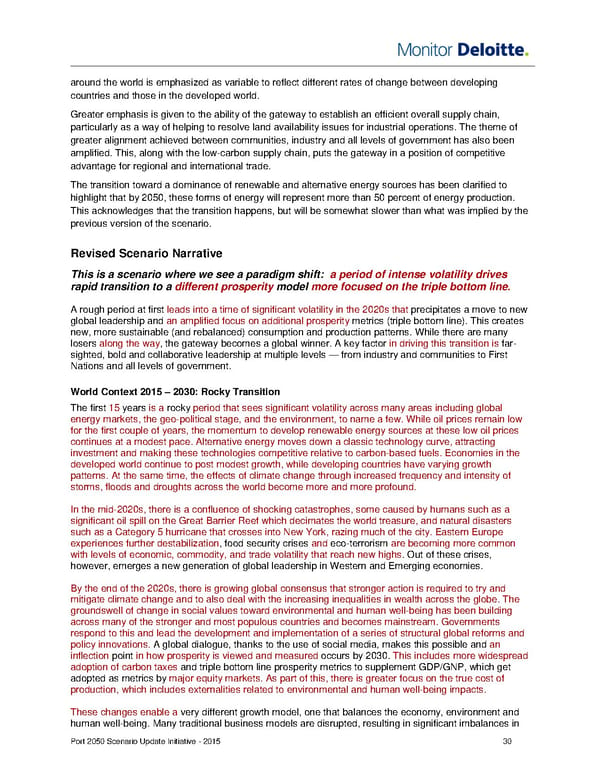around the world is emphasized as variable to reflect different rates of change between developing countries and those in the developed world. Greater emphasis is given to the ability of the gateway to establish an efficient overall supply chain, particularly as a way of helping to resolve land availability issues for industrial operations. The theme of greater alignment achieved between communities, industry and all levels of government has also been amplified. This, along with the low-carbon supply chain, puts the gateway in a position of competitive advantage for regional and international trade. The transition toward a dominance of renewable and alternative energy sources has been clarified to highlight that by 2050, these forms of energy will represent more than 50 percent of energy production. This acknowledges that the transition happens, but will be somewhat slower than what was implied by the previous version of the scenario. Revised Scenario Narrative This is a scenario where we see a paradigm shift: a period of intense volatility drives rapid transition to a different prosperity model more focused on the triple bottom line. A rough period at first leads into a time of significant volatility in the 2020s that precipitates a move to new global leadership and an amplified focus on additional prosperity metrics (triple bottom line). This creates new, more sustainable (and rebalanced) consumption and production patterns. While there are many losers along the way, the gateway becomes a global winner. A key factor in driving this transition is far- sighted, bold and collaborative leadership at multiple levels — from industry and communities to First Nations and all levels of government. World Context 2015 – 2030: Rocky Transition The first 15 years is a rocky period that sees significant volatility across many areas including global energy markets, the geo-political stage, and the environment, to name a few. While oil prices remain low for the first couple of years, the momentum to develop renewable energy sources at these low oil prices continues at a modest pace. Alternative energy moves down a classic technology curve, attracting investment and making these technologies competitive relative to carbon-based fuels. Economies in the developed world continue to post modest growth, while developing countries have varying growth patterns. At the same time, the effects of climate change through increased frequency and intensity of storms, floods and droughts across the world become more and more profound. In the mid-2020s, there is a confluence of shocking catastrophes, some caused by humans such as a significant oil spill on the Great Barrier Reef which decimates the world treasure, and natural disasters such as a Category 5 hurricane that crosses into New York, razing much of the city. Eastern Europe experiences further destabilization, food security crises and eco-terrorism are becoming more common with levels of economic, commodity, and trade volatility that reach new highs. Out of these crises, however, emerges a new generation of global leadership in Western and Emerging economies. By the end of the 2020s, there is growing global consensus that stronger action is required to try and mitigate climate change and to also deal with the increasing inequalities in wealth across the globe. The groundswell of change in social values toward environmental and human well-being has been building across many of the stronger and most populous countries and becomes mainstream. Governments respond to this and lead the development and implementation of a series of structural global reforms and policy innovations. A global dialogue, thanks to the use of social media, makes this possible and an inflection point in how prosperity is viewed and measured occurs by 2030. This includes more widespread adoption of carbon taxes and triple bottom line prosperity metrics to supplement GDP/GNP, which get adopted as metrics by major equity markets. As part of this, there is greater focus on the true cost of production, which includes externalities related to environmental and human well-being impacts. These changes enable a very different growth model, one that balances the economy, environment and human well-being. Many traditional business models are disrupted, resulting in significant imbalances in Port 2050 Scenario Update Initiative - 2015 30
 Monitor Deloitte - Final Report Page 31 Page 33
Monitor Deloitte - Final Report Page 31 Page 33